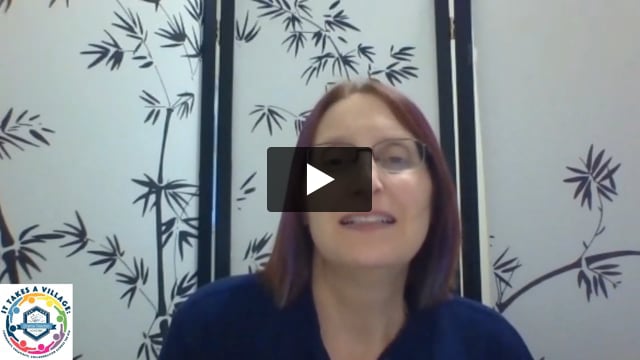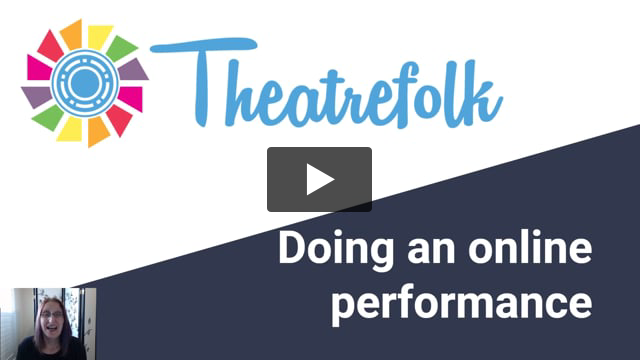Rehearsal and Production
6 ft Scenes
A collection of 15 scenes in which no two characters get within six feet of each other. Use them to explore the physical and emotional distance between people - what causes us to stay apart? Great for class work and competition, and where social distancing is required in class.
Read More...
Read Less...
A Midsummer Night's Dream Character Warm-up
Use this exercise in the early days of rehearsal or even as part of your audition process. It allows students to get into the physical side of a character without having to worry about hitting the “thees” and “thous.” This works well with any Shakespeare play.
Read More...
Read Less...
Active Verb List
This 3 page list of active verbs will help to get action out of your actors in a scene. Encourage the actors to play both physically and vocally with the verb.
Read More...
Read Less...
Alternative Performance - Interview with Lauren Carr
An interview with Lauren Carr - discussing alternative performance options.
Read More...
Read Less...
Audition Advice
Four key steps to preparing for an audition are outlined in this guide that will help students prepare for auditions.
Read More...
Read Less...
Be Amazing In Two Minutes Or Less
An audition guide for student actors. Covers choosing, preparing, and performing monologues. Plus - how to process feedback.
Read More...
Read Less...
Becoming a Professional Actor: Acting School
Some professional actors attend an acting school after high school. Some don’t. Which is the right
path? Training is never a bad thing. But there’s no one answer to the kind of training a professional
actor needs.
Read More...
Read Less...
Becoming a Professional Actor: Avoiding Scams
Young actors fall prey to scams every day. They so want to be in the business, they’ll do anything to make it happen. Unfortunately there are many people out there who know this and will also do anything to get money out of the naive actor. Read this guide to learn how to avoid scams for actors starting out.
Read More...
Read Less...
Becoming a Professional Actor: Headshots and Resumes
Headshots and resumes are necessary. They say what you look like and what you’ve done. If you want to become a professional actor it’s important to know the ins and outs of both. Make them simple and straightforward. No bells and whistles. This guide has all your student actors need to know.
Read More...
Read Less...
BIPOC Casting Directors and Producers
This list compiles names of casting directors and producers of colors who are doing the work to make change. BIPOC students do not have to go into the room and try to be anything or prove themselves to white producers. They should be able to see themselves behind the table. As we work on equity and inclusion think about who is behind the table. Discuss what can be done to create change. How can we create equitable and representative spaces for BIPOC students not just on the stage but behind the table as well? This list makes it known that BIPOC students can be producers and can be casting directors. There is room for us all at the table.
Read More...
Read Less...
BIPOC Streaming Shows
In these times, it’s important to know if the BIPOC play you want to do can be livestreamed, recorded, or performed virtually. We’ve put together a list of plays and playwrights with all that information.
As with all classroom material, it is incumbent on the instructor to familiarize themselves with the material before introducing it to their classes. Read the plays first to make sure they fit within any district guidelines with regard to language and subject matter.
Read More...
Read Less...
Bringing Black and Latinx Plays & Playwrights into the Drama Classroom
Every year we see top ten lists containing the most popular plays performed by students and studied in the drama classroom. Shakespeare makes the list every year. So does Arthur Miller. Some say that Our Town is performed every day of the year.
What is decidedly lacking from these lists are Black and Latinx plays and playwrights. These playwrights are writing and have been writing plays for years tackling the same themes as those on these top ten lists. The Theatrefolk Equity, Diversity & Inclusion Advisory Panel has assembled suggestions to include on your list for production and classroom study.
Read More...
Read Less...
Character Menu
This exercise is a way for students to show how well they know a character.
Read More...
Read Less...
Creating a Director's Vision
Where does a director start with a play? Start with questions. Use this series of analytical and conceptual questions on your chosen text.
Read More...
Read Less...
Creative Staging Part 1
Attachments
Creative Staging Part 2
Attachments
Devising
Recorded at the DTA Virtual Conference in July 2019, Amy Patel takes us through her devising process in the drama classroom.
Read More...
Read Less...
Attachments
Directing Style Chart
This resource helps students and directors consider the style of a play: naturalism, epic theatre, classical/neoclassical, expressionism, surrealism, impressionism, romanticism, hyperrealism, and others.
Read More...
Read Less...
Do's and Don'ts for Producing BIPOC Plays
Use this list as a discussion starter for your students, or as a point of reference for your next production.
Read More...
Read Less...
Duo Scene Information Sheet
Use this template to track a duo scene, including play details, character details, objectives, obstacles, tactics, and more.
Read More...
Read Less...
Getting Ready to Direct your First Virtual Play
Virtual productions are popping up everywhere now, specifically designed to be performed online, and they are a wonderful way to keep your students together and keep their love of theatre going – just in a different way. If you’re thinking about doing a virtual production, here are a few tips to help you on your way.
Read More...
Read Less...
How to do an Online Performance of a Play
Tips on doing an online performance using a video conferencing tool such as Zoom.
Read More...
Read Less...
How To Prepare a Theatrical Resume
Tips and tricks for preparing a Theatrical Resume - as well as a sample for students to start from.
Read More...
Read Less...
Learning Lines
Learning lines comes easy for some and not so easy for others. Download these exercises you can use with your students to get those lines down pat.
Read More...
Read Less...
Memorization Tips, Tricks and Techniques
It’s a question that comes up time and time again - How do I get my students to memorize their lines. What strategies do you use? Here are 7 strategies for students to use both on their own, and in rehearsal.
Read More...
Read Less...
Monologue Information Sheet
Use this template to track a monologue, including play details, character details, objectives, obstacles, tactics, and more.
Read More...
Read Less...
Participation/Positive Contribution Rehearsal Rubric
A rubric for a student to assess a partner's positive contribution and participation in rehearsals.
Read More...
Read Less...
Participation/Positive Contribution Rehearsal Rubric - Evaluator
This handout is designed for an evaluator to assess rehearsal participation and positive contribution. Two rubrics per page.
Read More...
Read Less...
Participation/Positive Contribution Rehearsal Rubric - Student Handout
This page is designed to be cut into four so each student has a small rubric to follow, for their participation and positive contribution to rehearsals.
Read More...
Read Less...
Poster: The Role of the Audience
A printable poster for your classroom - with some key reminders of the role of the audience.
Read More...
Read Less...
Poster: Theatre Audience Etiquette
A printable poster for your classroom or theatre - a few simple rules for theatre audience etiquette!
Read More...
Read Less...
Public Domain BIPOC Plays
This resource is a of plays in the Public Domain by BIPOC writers, including links as to where you can find the texts. Any translations included are also in the Public Domain. Not all texts are available in an English translation but we have included them in their original language. We have included cautions, but as always, please make sure you read/review the scripts before sharing with your students.
Read More...
Read Less...
Public Domain BIPOC Short Stories
This resource is a list of poems and short stories in the Public Domain by BIPOC writers including links as to where you can find the texts. Any translations included are also in the Public Domain. Not all texts are available in an English translation but we have included them in their original language. Please make sure you read/review the texts before sharing with your students.
Read More...
Read Less...
Reflection Sheets
A set of six reflection worksheets to use in rehearsals, group activities, and performance.
Read More...
Read Less...
Rehearsal Exercises
When you’ve been working on a scene for class or within a play for a while, sometimes things get stale. You know there’s something wrong with the moment, but can’t figure out what it is or where to go. Try these rehearsal exercises to shake up scene work.
Read More...
Read Less...
Sample Rehearsal Schedule with Exercises
This is a sample six rehearsal schedule for a full length play. Use this as a model and modify according to your and your students' needs.
Read More...
Read Less...
Scene Work: Where do I Start?
What steps should you take before you start rehearsals? Use this 8 step handout to get your students ready to rehearse.
Read More...
Read Less...
The Basics of Theatrical Performance
10 basics for performers to consider when evaluating their theatrical performance.
Read More...
Read Less...
The Five Keys every Actor Needs to Know
Learn the five keys that every actor needs to know when rehearsing a play - designed to help students to their best work.
Read More...
Read Less...
What Does Your Character Want to DO?
The actor has to only ask one question—what does the character want to do? (Bill Ball, A Sense of Direction)
• The to-do part is essential. It leads to action, and action is at the core of the acting process.
• That’s why it’s called acting, not talking.
• The to-do provides the character with a purpose.
This resource offers a list of potential 'to-do's to apply to scene work.
Read More...
Read Less...
What STOPS Your Character?
Obstacles are the barriers and limitations the character must overcome to achieve their goal.
• Obstacles can be internal, such as emotional, psychological factors.
• External obstacles include an “other.”
• Obstacles are not limitations. Plays are about characters in conflict, characters in crisis.
• Obstacles spark creativity.
This worksheet helps actors define the obstacles in their scene work. What stops YOUR character?
Read More...
Read Less...
Who's Who in the Theatre?
This handout lists all of the roles and positions that make up a theatre company.
Read More...
Read Less...
© Copyright 2015-2024 Theatrefolk




